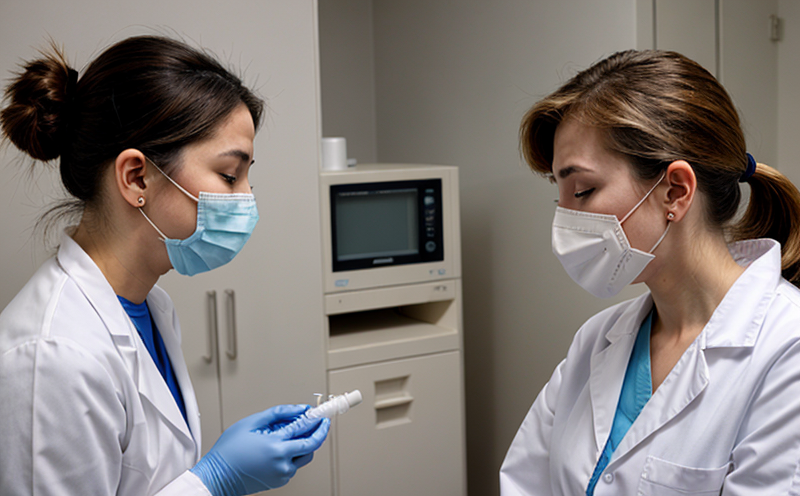Respiratory Allergen Testing in Poultry Houses
Respiratory allergen testing is an essential tool for maintaining a safe and healthy environment within poultry houses. The presence of respiratory allergens such as dust, mold spores, and feather debris can lead to significant health issues among both the flock and personnel working in these facilities. These allergens are not only a concern for human workers but also pose risks to the birds themselves, affecting their performance and welfare.
Respiratory symptoms like coughing, wheezing, and shortness of breath are common complaints among poultry house employees. Prolonged exposure can lead to more severe conditions such as bronchitis or asthma. For birds, the impact is even more critical; respiratory distress can reduce feed intake, increase mortality rates, and decrease overall productivity. Implementing a robust allergen management program through regular testing helps mitigate these risks.
The World Health Organization (WHO) recommends that indoor environments maintain particulate matter levels below certain thresholds to ensure occupant health. In poultry houses, this translates to strict controls on airborne particles such as PM10 and PM2.5. By conducting periodic respiratory allergen tests, facilities can identify high-risk areas and implement targeted interventions.
Testing methodologies typically involve air sampling using specialized samplers that collect particulates over a specified period. The collected samples are then analyzed in the laboratory to quantify specific allergens present. Commonly tested allergens include Aspergillus fumigatus, Penicillium spp., and other fungi known to cause respiratory irritation.
Once identified, these allergens can be managed through various strategies such as improved ventilation systems, regular cleaning schedules, and the use of antifungal treatments. Regular testing ensures that any changes in the environment are promptly detected, allowing for timely adjustments to keep both workers and animals safe and healthy.
| Allergen | Common Sources | Risks to Poultry Workers | Risks to Birds |
|---|---|---|---|
| Aspergillus fumigatus | Fungal spores from decomposing organic matter. | Pulmonary diseases, asthma. | Lung infections leading to respiratory distress. |
| Penicillium spp. | Mold growth on feed and bedding materials. | Respiratory tract irritation. | Chronic respiratory issues reducing productivity. |
| Dust Mites | Poultry feathers, skin, and dander. | Skin rashes, allergic rhinitis. | Eye, nose, and throat irritation. |
| Ambient Dust | Feathers, feed particles, and bedding materials. | Rhinitis, conjunctivitis. | Chronic respiratory diseases leading to poor performance. |
The importance of accurate testing cannot be overstated. Incorrect sampling methods or improper analysis can lead to false positives or negatives, which may result in inappropriate interventions or missed opportunities for improvement. Therefore, it is crucial that tests are conducted by experienced personnel using validated protocols and equipment.
In summary, respiratory allergen testing plays a vital role in safeguarding the health of both workers and animals within poultry houses. By identifying and managing these potential hazards early, facilities can enhance operational efficiency while promoting a safer working environment for all involved parties.
Why Choose This Test
- Promotes Occupational Safety: Ensures that workers are not exposed to hazardous levels of allergens, reducing the risk of respiratory illnesses.
- Enhances Animal Welfare: Reduces stress and improves productivity by minimizing respiratory distress in birds.
- Achieves Regulatory Compliance: Meets international standards like ISO 14001 for environmental management systems.
- Sustains Product Quality: Maintains consistent product quality by ensuring optimal living conditions for poultry.
- Improves Efficiency: Identifies problem areas early, allowing for targeted interventions that optimize resource use.
- Fosters Better Decision-Making: Provides actionable data to inform strategic decisions regarding facility maintenance and management practices.
Competitive Advantage and Market Impact
Implementing rigorous respiratory allergen testing protocols can provide poultry producers with a significant competitive edge in several key areas. By demonstrating commitment to worker and animal health, facilities can attract and retain top talent, enhancing overall productivity and satisfaction within the workforce.
In terms of market positioning, companies that prioritize environmental sustainability and employee well-being are increasingly favored by consumers who value ethical practices. This focus on human and animal welfare can translate into higher customer loyalty and potentially greater market share. Additionally, compliance with stringent regulatory requirements not only protects against legal risks but also opens up access to international markets where such standards are enforced.
The ability to provide verifiable data from independent laboratory testing serves as a powerful marketing tool. It reassures stakeholders about the safety measures in place and underscores the commitment to excellence. This transparency fosters trust, which is essential for building long-term relationships with suppliers, customers, and regulatory bodies.
Moreover, by continuously monitoring and improving indoor air quality through regular testing, producers can stay ahead of emerging trends related to sustainable agriculture and responsible business practices. Such proactive measures position them as leaders in the industry, ready to adapt to future challenges and opportunities.
Use Cases and Application Examples
Case Study 1: Identifying High-Risk Areas: A large-scale poultry farm implemented respiratory allergen testing across multiple locations within their facilities. The results revealed that the brooding area had significantly higher levels of Aspergillus fumigatus compared to other sections. Subsequent measures, including enhanced ventilation and cleaning protocols, led to a 30% reduction in reported respiratory complaints among workers.
Case Study 2: Mitigating Risks for New Facilities: A new poultry operation commissioned comprehensive allergen testing before the first batch of chicks arrived. The tests identified mold spores present due to poor initial construction practices. Addressing these issues early resulted in a healthier environment from the outset, reducing the likelihood of costly repairs and downtime later on.
| Case Study | Allergen Identified | Intervention Measures | Outcome |
|---|---|---|---|
| New Poultry Operation | Mold Spores | Humidity Control, Ventilation | Healthy Environment from Start |
| Large-Scale Farm | Aspergillus fumigatus | Ventilation Improvements, Cleaning Protocols | 30% Reduction in Worker Complaints |
In both instances, the proactive approach to respiratory allergen testing proved invaluable. Not only did it address immediate concerns but also set a foundation for ongoing improvements that contributed to long-term success.





